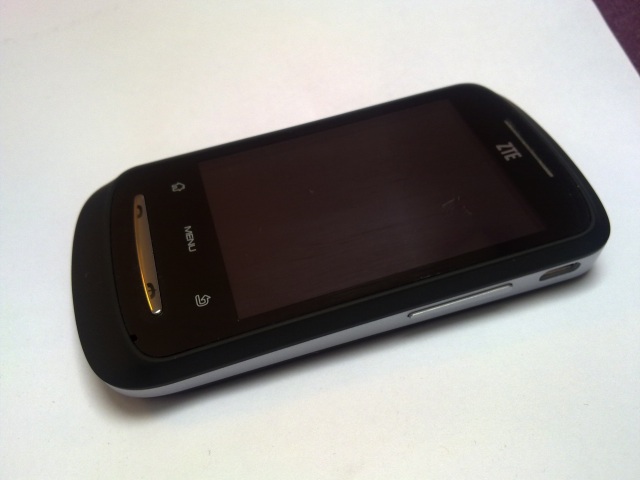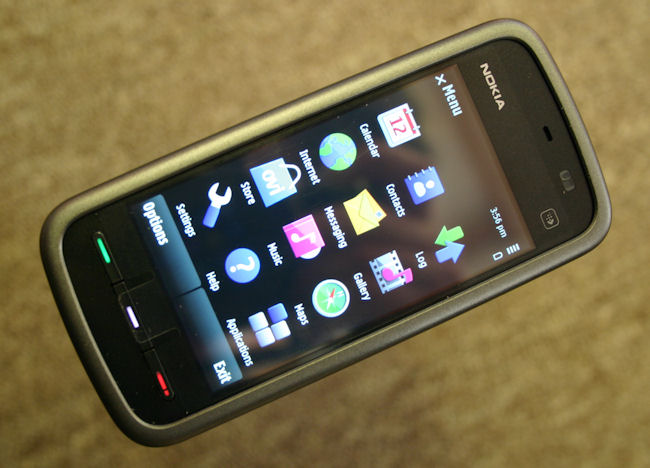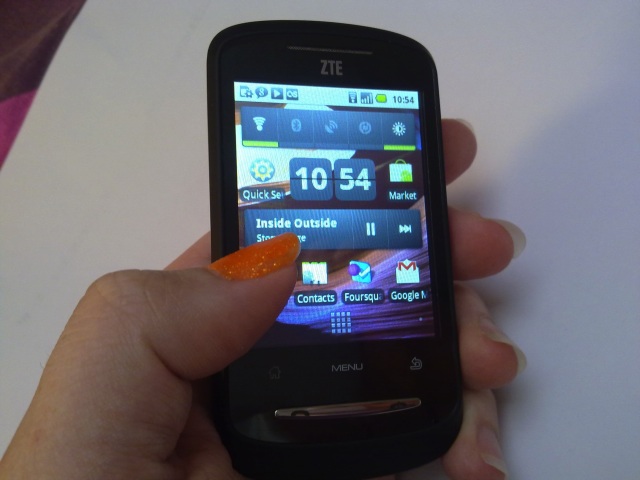
In previous years, the first thing tech websites looked at were the specifications of a mobile phone. As I continue to look at the Nokia 5230 (Symbian S60 5th Edition) and the ZTE Racer (Android), how do these two smarthones available for under £100 compare in terms of raw numbers? And does it matter?
Let's start with the frequencies supported by the phones. We're used to quad band GSM smartphones, so the loss of one of them in the ZTE Racer (sometimes known as the ZTE X85)) makes it a tri band (900/1800/1900) model. If you are going to be travelling, you might have to do the old fashioned thing of checking the frequencies of the networks you'll be roaming on.
The Nokia 5230 covers all four frequencies, so is pretty much a global phone and if you're a international frequent traveller this could be an important consideration. But what the 5230 gives with one hand, it takes away with another. The 5230 does not have Wi-fi.
This isn't as much of a problem as you would initially expect. As long as you have a sensible data package then you'll be able to do most of your data over 3G (dual band, supported by both phones, though the frequencies again vary slightly in the 5230's case) – just be sensible and use a PC connection to grab music and sideload mapping data and big application downloads and you'll be fine. I found that 50MB of data for a two week trip in the US was sufficient, so even snagging a 500MB or 1GB plan and you can take your eyes off the bandwidth clock.
Of course Wi-fi nice to have, and if part of your day is sitting around an office or workplace that does have Wi-fi then this is going to be part of your consideration when deciding which device to go for, because as well as 3G, the ZTE Racer does have Wi-fi. It's the older version of Wi-fi, which is not as fast, but it is there, alongside the 3G circuitry, although the 3G on the Racer is limited to 7.2 Mbps (as opposed to more expected 10.2 Mbps on the higher end smartphones). The 5230 has 3G that maxes out at 3.6Mbps. So it looks slower on paper, but really if you're not right under the cell tower, you'll never get close to even the 3.6Mbps speed.
When a company is going for a budget, you juggle components and bulk buying to get the cost down. This is an area you can compromise to get the price point to under £100, because people will ask if it has Wi-Fi, 3G and maybe GPS. If the shop assistant says yes, they're happy, and the sale is made.
All these specs might be fun for the geeks, but it doesn't matter as much in this market as it does with the high-end devices. People buying these phones are not looking for an extra 50Hz of processing power because the temperature can be lowered, they're not looking to squeeze another few millimetres of macro zoom or the perfect reproduction of Jeff Wayne's Musical Version of the War of the Worlds.
What the regular phone users (and that's the market that is going to pick up these phones) are looking for is not the same as power users. They want a reliable phone, they want a phone that does what they want it to do, and it needs to just work. That's actually a pretty tall challenge.
For example, the power users are going to be happy to grab third party applications to fix functionality that is missing in the operating system. For everyone else, it just feels like something is missing.
Symbian, especially in S60, has a pretty solid feature set, so most of the holes that you would expect to be covered are already part of the firmware. So in that sense it does just work – the problem is that to get to the settings and icons to adjust these basic functions is not a simple thing to do. The options are spread out over apps or hiding in a mammoth multi-page application icon.
Android fares little better. Yes, the settings are all together from the main menu, but there's not a huge amount you can change here. In terms of functionality, there's quite a bit missing from the Android OS. Yes, it's being filled in by third party applications, but I'm not sure that's a valid solution. If you're happy with the out of the box set-up, then Android is great, but you can't deviate too much away the norm without a lot of hacking and extra applications.
Neither of the handsets make it easy to tweak your phone, and while out of the box is good enough for most people, they can't step away too much from this without some serious study.
And why is it that Android keeps looking for an Internet connection? When in Wi-fi coverage, the ZTE Racer switches to that to get a connection. If outside of Wi-fi, the handset switches to 3G and goes online. No matter what the external conditions, or apps opened, Android is constantly looking to get online and stay online. Which might be fine in a Silicon Valley lab or on a high-end £30-£50/month contract phone, but not on a contract-free phone.
Let alone the impact it has on battery life. With “auto-sync” running in the background, making sure Google Mail, contacts and calendar are always matched up with the version in the cloud, you'll be hard pushed to get to late lunch with this all running. Where does it say you need to switch this off to save battery life? And that you need a third party application to suspend the data connection (ApnDroid)?

When you're asked the difference in ethos between Symbian OS and Android, here's a big one. Symbian (and Epoc before it) was designed to run in constrained circumstances, both in hardware but also in connectivity. Symbian works as as an online and offline computer. Android is essentially a computer that thinks it will be 'on' all the time. It's a vital distinction both in ethos and use.
Where do you notice it? Battery life. Keeping a 3G connection open (even if not used) drains the battery and the ZTE racer can barely manage through to mid afternoon without a top up charge (thankfully over microUSB). Using a hack/app to edit the Access Point Name allows you to drop offline and then you can manage a full day of out and about, with just a little bit of internet access when you need it. But forget about popping the headphones on to listen to some music, keeping Facebook updated and reading your mails at the same time. You can, but you'd better be carrying your charger.
The 5230? A working day and commute, with music, social networks, and general use, still with battery left over if you need it. Game set and power match to Symbian. It's not a huge difference in the battery capacity (1320mAh on the 5230, compared to 1100mAh on the Racer) but how the underlying operating system manages the power. That's not something that can be tweaked, it's a fundamental of the OS, starting at the kernel level.
I suspect Android will always be a battery hog. And remember this is on a low end device. Throw in the graphics cards and faster processors and it's going to hurt the battery life. But back to the Racer. It's tough to show the real life battery use in the stores, but this is not going to be seen as a good phone for battery life.
There's one other area that the Racer fails at. Switch on speed from the “black screen” it sits at in your pocket. There is a noticeable lag when you tap the power button (slightly recessed on the top of the unit, quite awkward, truth be told) before the lock screen comes up. The 5230 has a ridged sliding button, twitch on that and you're ready to rock. So it takes a second more on the Android device, but these seconds all add up.
Both devices use a resistive touch screen, which is only natural given the cost to the units. I was expecting some sort of revelation on the Android OS. Err, no. In fact quite the opposite. For all the complaints of the touch interface on S60 5th Edition, there are very few moments when you need pixel perfect accuracy on the touch screen to carry out a manoeuvre. Buttons are large enough to accommodate a finger pressing down. Yes there is a lack of consistency sometimes in terms of one tap and two taps, but if the choice is between that or frustrating button presses, then I'll take the former.
Because Android is a frustrating touch experience on a resistive screen. It is more cramped, and making accurate choices in the mail application, the tiny icons at the side of Google Maps, and the cramped keyboard make a stylus almost a pre-requisite for the device – and no, there isn't one in the box. In general Android needs a larger, capacitive screen with smart code to work out which spot is being pressed. Because on the resistive screens, especially the one on the Racer that requires a heavy press, it feels like a layer of treacle on the top.

The 5230 has one place where its screen fails to cope – and that's on the scrolling contact bars on the homescreen, so it's not unique to ZTE's devices, but it's much more noticeable during the day. And especially when entering any text on the device. A finger just isn't enough.
In terms of hardware, I'd give the budget battle to the 5230. The build quality is a little bit better, and while the screens are roughly the same physical size, the Nokia's 640x360 stomps all over the 320x240 Android screen. Even with more pixels it's easier to use the touch interface accurately on the 5230. Battery life on the 5230 is excellent, and Android can't hold a candle to it (in this price range) now or in the near future.
How about in day to day use though? We're told that Android is all about the software (first and third party) – in a sense that's true, because the hardware depends on the manufacturer, but when you split software and hardware you get problems (ask Psion, ask Palm, ask HP...) How does Android cope with the real world, doing the grunt work of emails, texts, browsing and social networks?
In the next article, I'll revisit the 5230 challenges, and see how the £100 Android device fares with them.
-- Ewan Spence, Aug 2010.
